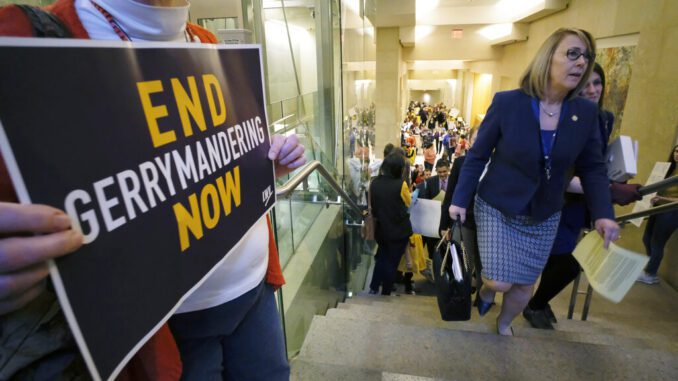
When voters in some states created new commissions to handle the politically thorny process of redistricting, the hope was that the bipartisan panelists could work together to draw new voting districts free of partisan gerrymandering.
Instead, cooperation has proved elusive.
In New York, Ohio and Virginia, commissions meeting for the first time this year have splintered into partisan camps to craft competing redistricting maps based on 2020 census data.
As a result, new state House and Senate districts in Republican-led Ohio will still favor the GOP. Democrats who control New York could still draw maps as they wish. And a potential stalemate in Virginia could eventually kick the process to the courts.
“It’s probably predictable that this is sort of how it’s panned out,” said Alex Keena, a political scientist at Virginia Commonwealth University who has analyzed redistricting and gerrymandering.
Redistricting can carry significant consequences. Subtle changes in district lines can solidify a majority of voters for a particular party or split its opponents among multiple districts to dilute their influence. Republicans need to net just five seats to regain the U.S. House in the 2022 elections, which could determine the fate of President Joe Biden’s remaining agenda.
Throughout most of American history, redistricting has been handled by state lawmakers and governors. But as public attention to gerrymandering has grown in recent decades, voters in some states have shifted the task to so-called special commissions.
Some commissions — such as those in Arizona, California, Colorado and Michigan — consist solely of citizens who hold the final say on what maps to enact. But others, such as in Ohio and Virginia, include politicians among their members or require their maps to be submitted to the legislature for final approval, as is the case in New York, Virginia and Utah.
If New York’s Democratic-led Legislature rejects the work of the new commission (consisting for four Democrats, four Republicans and two independents), then lawmakers can draft and pass their own redistricting plans.
The prospects of that increased last week, when Democrats and Republicans on the commission failed to agree and instead released competing versions of new maps for the U.S. House, state Senate and state Assembly.
State Republican Party Chairman Nick Langworthy blasted the Democratic maps as “wildly gerrymandered” and accused Democratic commissioners of refusing to compromise.
State Democratic Party Chairman Jay Jacobs countered that there was no reason to “bend over backwards” to try to draw as many Republican seats as possible. He added: “We’ll be fair, but to a point.”
The commission’s division frustrated Jennifer Wilson, deputy director of the League of Women Voters of New York. The organization supported the 2014 ballot measure that created the commission and encouraged people to testify at the panel’s public hearings this year.
“It almost feels like a slap in the face to us and to all those people who spent the time to go and submit comments — took time out of their daily lives to do that — when it’s very obvious there was no regard for any of those comments,” Wilson said.
Michigan’s citizen redistricting commission released its first draft of a new state Senate and U.S. House map this past week and is still working on a state House map. It’s planning to take more public comment on its proposals with a goal of finalizing maps by the end of the year — blowing past the Nov. 1 deadline set in the constitutional amendment approved by voters.
In Virginia, two separate mapmakers hired for Democrats and Republicans are to submit rival plans for consideration this coming week by the 16-member commission, which has four lawmakers and four citizens from each major party. If the commission can’t agree — or the Democratic-led General Assembly rejects its maps — the decision will fall to the state Supreme Court, which is dominated by GOP-appointed judges.
How commissioners respond to the two maps will determine whether the reform effort works, said Liz White, executive director of OneVirginia2021, which supported last year’s ballot measure creating the commission. She hopes panelists find a way “to marry” the two proposals.
“We’re going to be able to look back on this sort of experiment and see what works and what doesn’t work,” White said. “Hopefully, that will lead to better reforms in the future.”



